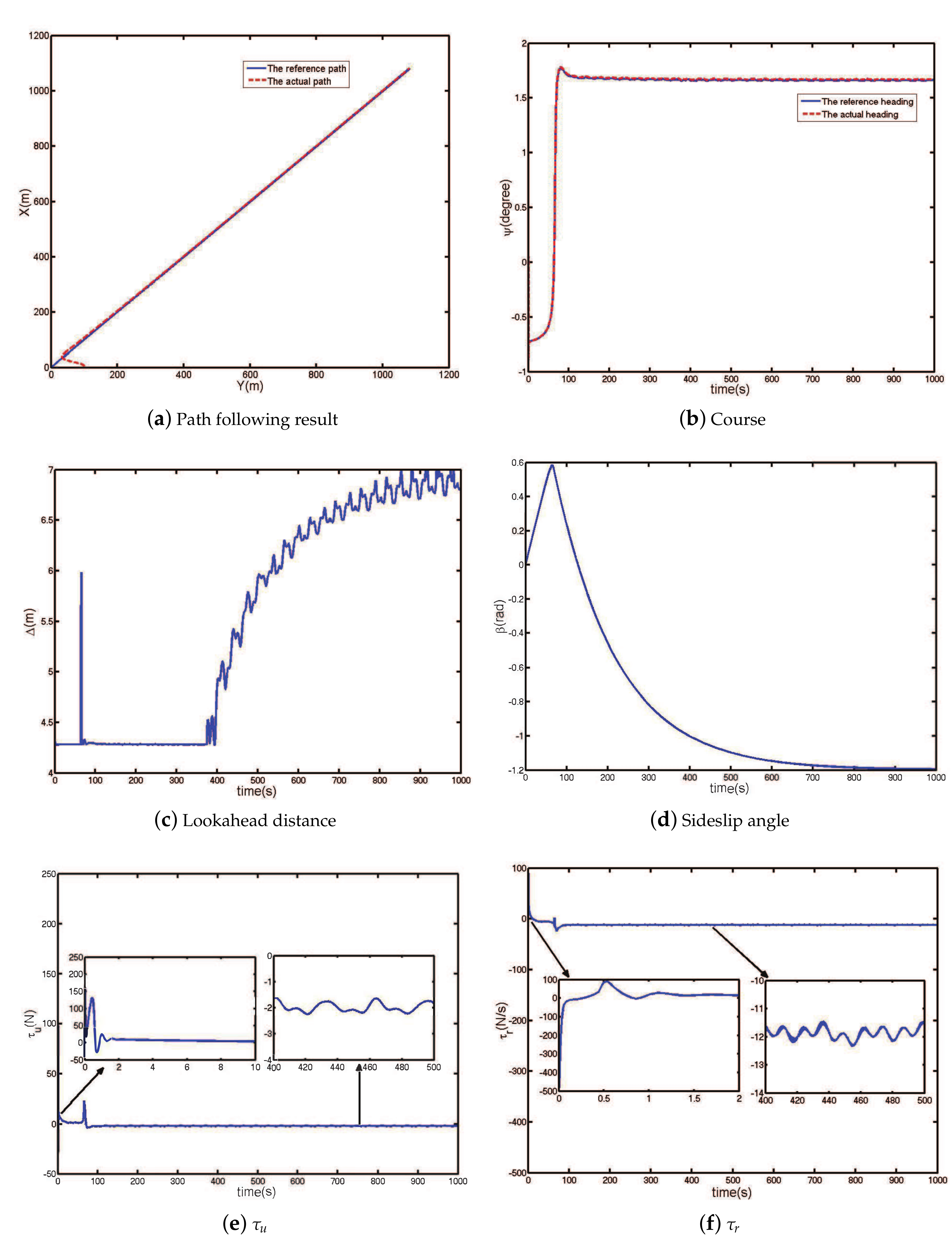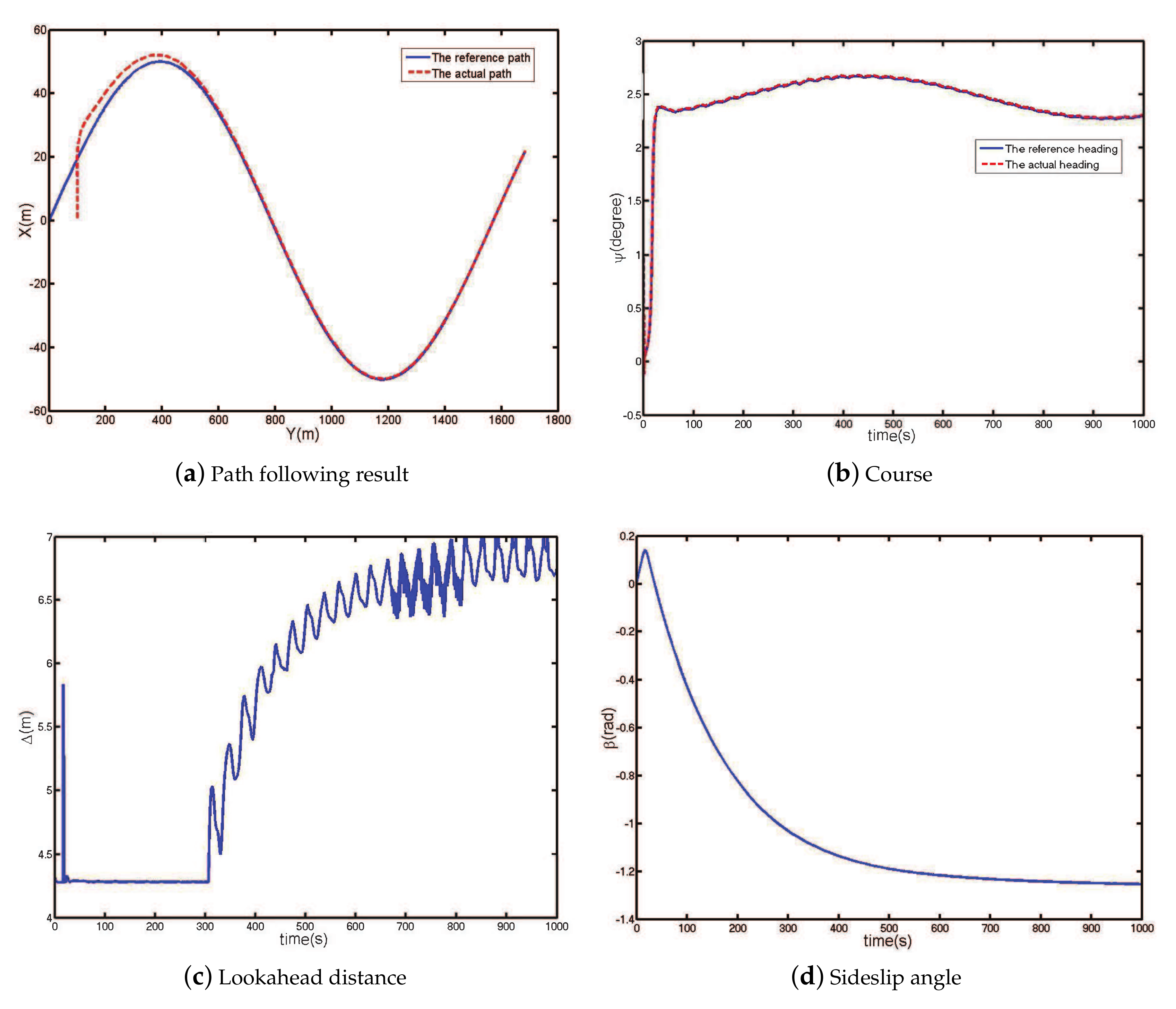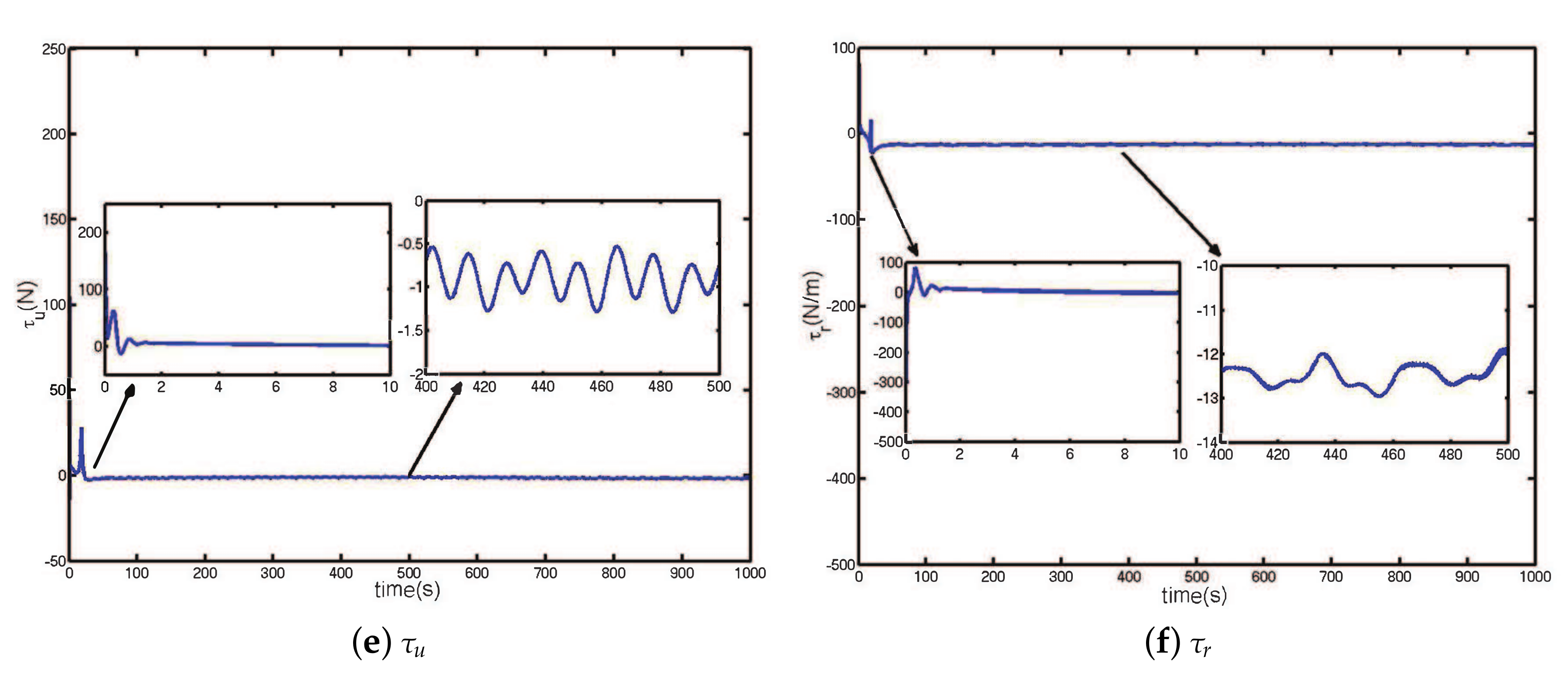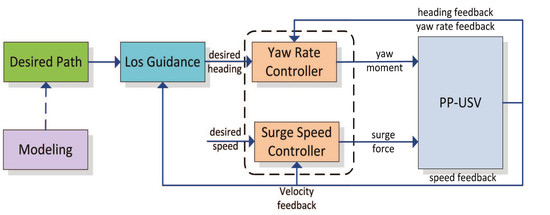Adaptive LOS Path Following for a Podded Propulsion Unmanned Surface Vehicle with Uncertainty of Model and Actuator Saturation
Abstract
:1. Introduction
- (1)
- Based on force analysis and MMG (Ship Manoeuvring Mathematical Model Group)separation modeling theory, the podded propulsion USV is proven to be an underactuated system.
- (2)
- An improved LOS algorithm is employed as a navigation strategy for USV, which means that it not only ensures the expected compensation effect, but also avoids the use of expensive sensor equipment.
- (3)
- A novel neural shunting model is adopted to deal with the “explosion of complexity”, which can reduce the computational complexity of the control system.
- (4)
- Model uncertainties and time-varying external disturbances are estimated by the neural network minimum parameter learning method. Compared with RBF and BP, the neural network minimum parameter learning method has a smaller amount of computation.
- (5)
- The auxiliary dynamic system is introduced to prevent the input saturation problem, which is closer to practical engineering.
2. Modeling of USV
2.1. Kinematics Equation
2.2. Kinetic Equation
3. LOS Guidance Algorithms
3.1. Problem Formulation
3.2. Adaptive Compensation of the Sideslip Angle
3.3. Time-Varying Lookahead Distance
- (1)
- and are normalized to ; the data domain of ℑ is .
- (2)
- is equally divided into NB, NS, Z, PS and PB; is equally divided into NB, NS, Z, PS and PB; ℑ is equally divided into VS, S, M, B and VB.
- (3)
- Zadeh and max-min are used for fuzzy reasoning. Meanwhile, the centroid area center of gravity method is used for defuzzification.
4. Control System Design
4.1. Preliminary Knowledge
4.1.1. Neural Network Minimum Parameter Learning Method
4.1.2. Neural Shunting Model
4.1.3. Input Saturation
4.2. Yaw Rate Controller
4.3. Surge Speed Controller
5. Stability Analysis
5.1. Stability of the Controller
5.2. Stability of the Closed-Loop System
6. Numerical Simulations
6.1. Straight-Line Path Following
6.2. Curve Path Following
6.3. Control Parameter Setting Strategy
- (1)
- For the navigation system, larger values of gain and adaptive gain mean that the sideslip angle can converge at a faster rate. Meanwhile, and can also affect the convergence rate. A fast convergence rate means that the sideslip angle can be compensated better, but it certainly adds to the possibility of oscillation or divergence in the navigation system.
- (2)
- Larger gains and do not affect the amplitude of generated control signals in (41) and (47). They are adjusted to get the desired following performance without consideration of the actuator saturation. Nevertheless, larger and may cause unnecessary chattering of the control signals.
- (3)
- Large values of adaptive gains and in (44) and (50) increase the learning speed of the neural network minimum parameter learning method. This means that USV can obtain more accurate following performance. However, too fast a learning speed will affect the stability of the control system. and are used to optimize (44) and (50), respectively.
- (4)
- , A, B and D can affect the response speed of the control system. Faster system response enables USV to reach the reference path in a shorter time, but it also raises the possibility of system instability.
- (5)
- , , and are employed to adjust the auxiliary dynamic system. Only a suitable set of parameters can be used to achieve the desired results.
7. Conclusions
Supplementary Files
Supplementary File 1Acknowledgments
Author Contributions
Conflicts of Interest
Abbreviations
| USV | unmanned surface vehicle |
| DOF | degree of freedom |
| LOS | line of sight |
| UUB | uniformly ultimately bounded |
| UGES | uniformly globally exponentially stable |
| UGAS | uniformly globally asymptotically stable |
| ALOS | adaptive line of sight |
| ILOS | integral line of sight |
| PLOS | predictor-based line of sight |
| DSC | dynamic surface control |
| MPC | model predictive control |
| RBF | radial basis function |
| BP | back propagation |
| PP | podded propulsion |
References
- Sinisterra, A.J.; Dhanak, M.R.; Ellenrieder, K.V. Stereovision-based target tracking system for USV operations. Ocean Eng. 2017, 133, 197–214. [Google Scholar] [CrossRef]
- Yao, W.; Zhang, J.; Liu, Y.; Zhou, M.; Sun, M. Improved Vector Control for Marine Podded Propulsion Control System Based on Wavelet Analysis. J. Coast. Res. 2015, 73, 54–58. [Google Scholar] [CrossRef]
- Gierusz, W. Simulation model of the LNG carrier with podded propulsion Part 1: Forces generated by pods. Ocean Eng. 2015, 108, 105–114. [Google Scholar] [CrossRef]
- Breivik, M. Topics in Guided Motion Control of Marine Vehicles. Ph.D. Thesis, NTNU, Trondheim, Norwegian, 2010. [Google Scholar]
- Wiig, M.S.; Pettersen, K.Y.; Krogstad, T.R. Uniform semiglobal exponential stability of integral line-of-sight guidance laws. IFAC-PapersOnLine 2015, 48, 61–68. [Google Scholar] [CrossRef] [Green Version]
- Lee, S.D.; Yu, C.H.; Hsiu, K.Y.; Hsieh, Y.G.; Tzeng, C.Y. Uniform semiglobal exponential stability of integral line-of-sight guidance laws. Ocean Eng. 2010, 37, 208–217. [Google Scholar] [CrossRef]
- Hac, A.; Simpson, M.D. Estimation of vehicle side slip angle and yaw rate. SAE Trans. 2000, 109, 1032–1038. [Google Scholar]
- Borhaug, E.; Pavlov, A.; Pettersen, K.Y. Integral los control for path following of underactuated marine surface vessels in the presence of constant ocean currents. In Proceedings of the 47th IEEE Conference on Decision and Control, Cancun, Mexico, 9–11 December 2008; pp. 4984–4991. [Google Scholar]
- Lekkas, A.M.; Fossen, T.I. Integral LOS Path Following for Curved Paths Based on a Monotone Cubic Hermite Spline Parametrization. IEEE Trans. Control Syst. Technol. 2014, 22, 2287–2301. [Google Scholar] [CrossRef]
- Fossen, T.I.; Pettersen, K.Y.; Galeazzi, R. Line-of-Sight Path Following for Dubins Paths with Adaptive Sideslip Compensation of Drift Forces. IEEE Trans. Control Syst. Technol. 2015, 23, 820–827. [Google Scholar] [CrossRef]
- Lu, L.; Wang, D.; Peng, Z.; Wang, H. Stereovision-based target tracking system for USV operations. Ocean Eng. 2016, 124, 340–348. [Google Scholar]
- Pavlov, A.; Nordahl, H.; Breivik, M. MPC-Based Optimal Path Following for Underactuated Vessels. IFAC Proc. 2009, 42, 340–345. [Google Scholar] [CrossRef]
- Lekkas, A.; Fossen, T.I. A Time-Varying Lookahead Distance Guidance Law for Path Following. IFAC Proc. 2012, 45, 398–403. [Google Scholar] [CrossRef]
- Lu, L.; Wang, D.; Peng, Z. Predictor-based line-of-sight guidance law for path following of underactuated marine surface vessels. In Proceedings of the 2015 Sixth IEEE International Conference on Intelligent Control and Information Processing (ICICIP), Wuhan, China, 26–28 November 2015; pp. 284–288. [Google Scholar]
- Garus, J.; Zak, B. Using of soft computing techniques to control of underwater robot. In Proceedings of the 2010 15th IEEE International Conference on Methods and Models in Automation and Robotics (MMAR), Miedzyzdroje, Poland, 23–26 August 2010; pp. 415–419. [Google Scholar]
- Meng, W.; Guo, C.; Liu, Y.; Yang, Y.; Lei, Z. Global sliding mode based adaptive neural network path following control for underactuated surface vessels with uncertain dynamics. In Proceedings of the 2012 Third IEEE International Conference on Intelligent Control and Information Processing (ICICIP), Dalian, China, 15–17 July 2012; pp. 40–45. [Google Scholar]
- Liu, L.; Wang, D.; Peng, Z. Path following of marine surface vehicles with dynamical uncertainty and time-varying ocean disturbances. Neurocomputing 2016, 173, 799–808. [Google Scholar] [CrossRef]
- Wu, D.; Chen, M.; Gong, H.; Wu, Q. Robust Backstepping Control of Wing Rock Using Disturbance Observer. Appl. Sci. 2017, 3, 219–248. [Google Scholar] [CrossRef]
- Jiang, G.; Luo, M.; Bai, K.; Chen, S. A Precise Positioning Method for a Puncture Robot Based on a PSO-Optimized BP Neural Network Algorithm. Appl. Sci. 2017, 10, 969–982. [Google Scholar]
- Tong, S.; Li, Y.; Sui, S. Adaptive Fuzzy Output Feedback Control for Switched Nonstrict-Feedback Nonlinear Systems with Input Nonlinearities. IEEE Trans. Fuzzy Syst. 2016, 24, 1426–1440. [Google Scholar] [CrossRef]
- Chao, C.; Sutarna, N.; Chiou, J.; Wang, C. Equivalence between Fuzzy PID Controllers and Conventional PID Controllers. Appl. Sci. 2017, 6, 513–525. [Google Scholar] [CrossRef]
- Wang, H.; Wang, D.; Peng, Z. Neural network based adaptive dynamic surface control for cooperative path following of marine surface vehicles via state and output feedback. Neurocomputing 2014, 133, 170–178. [Google Scholar] [CrossRef]
- Chen, M.; Ge, S.S.; Ren, B. Adaptive tracking control of uncertain MIMO nonlinear systems with input constraints. Automatica 2011, 47, 452–465. [Google Scholar] [CrossRef]
- Du, J.; Hu, X.; Krstić, M.; Sun, Y. Robust dynamic positioning of ships with disturbances under input saturation. Automatica 2016, 73, 207–214. [Google Scholar] [CrossRef]
- Wang, H.; Wang, D.; Peng, Z. Adaptive dynamic surface control for cooperative path following of marine surface vehicles with input saturation. Nonlinear Dyn. 2014, 77, 107–117. [Google Scholar] [CrossRef]
- Fossen, T.I. Marine Control Systems: Guidance, Navigation and Control of Ships, Rigs and Underwater Vehicles. In Marine Cybernetics; Springer: Trondheim, Norway, 2002. [Google Scholar]
- Zhang, G.; Zhang, X. A novel DVS guidance principle and robust adaptive path-following control for underactuated ships using low frequency gain-learning. Isa Trans. 2015, 56, 75–85. [Google Scholar] [CrossRef] [PubMed]
- Li, J.H.; Lee, P.M.; Jun, B.H.; Lin, Y.K. Point-to-point navigation of underactuated ships. Automatica 2008, 44, 3201–3205. [Google Scholar] [CrossRef]
- Ge, S.S.; Wang, C. Direct adaptive NN control of a class of nonlinear systems. IEEE Trans. Neural Netw. 2002, 13, 214–221. [Google Scholar] [CrossRef] [PubMed]
- Chen, B.; Liu, X.; Liu, K.; Lin, C. Direct adaptive fuzzy control of nonlinear strict-feedback systems. Automatica 2009, 45, 1530–1535. [Google Scholar] [CrossRef]
- Yang, Y.; Du, J.; Liu, H.; Abraham, A. A Trajectory Tracking Robust Controller of Surface Vessels with Disturbance Uncertainties. IEEE Trans. Control Syst. Technol. 2014, 22, 1511–1518. [Google Scholar] [CrossRef]
- Dai, S.L.; Wang, C.; Luo, F. Identification and Learning Control of Ocean Surface Ship Using Neural Networks. IEEE Trans. Ind. Inform. 2012, 8, 801–810. [Google Scholar] [CrossRef]
- Pan, C.Z.; Lai, X.Z.; Yang, S.X.; Wu, M. An efficient neural network approach to tracking control of an autonomous surface vehicle with unknown dynamics. Expert Syst. Appl. 2013, 40, 1629–1635. [Google Scholar] [CrossRef]






© 2017 by the authors. Licensee MDPI, Basel, Switzerland. This article is an open access article distributed under the terms and conditions of the Creative Commons Attribution (CC BY) license (http://creativecommons.org/licenses/by/4.0/).
Share and Cite
Mu, D.; Wang, G.; Fan, Y.; Sun, X.; Qiu, B. Adaptive LOS Path Following for a Podded Propulsion Unmanned Surface Vehicle with Uncertainty of Model and Actuator Saturation. Appl. Sci. 2017, 7, 1232. https://doi.org/10.3390/app7121232
Mu D, Wang G, Fan Y, Sun X, Qiu B. Adaptive LOS Path Following for a Podded Propulsion Unmanned Surface Vehicle with Uncertainty of Model and Actuator Saturation. Applied Sciences. 2017; 7(12):1232. https://doi.org/10.3390/app7121232
Chicago/Turabian StyleMu, Dongdong, Guofeng Wang, Yunsheng Fan, Xiaojie Sun, and Bingbing Qiu. 2017. "Adaptive LOS Path Following for a Podded Propulsion Unmanned Surface Vehicle with Uncertainty of Model and Actuator Saturation" Applied Sciences 7, no. 12: 1232. https://doi.org/10.3390/app7121232





